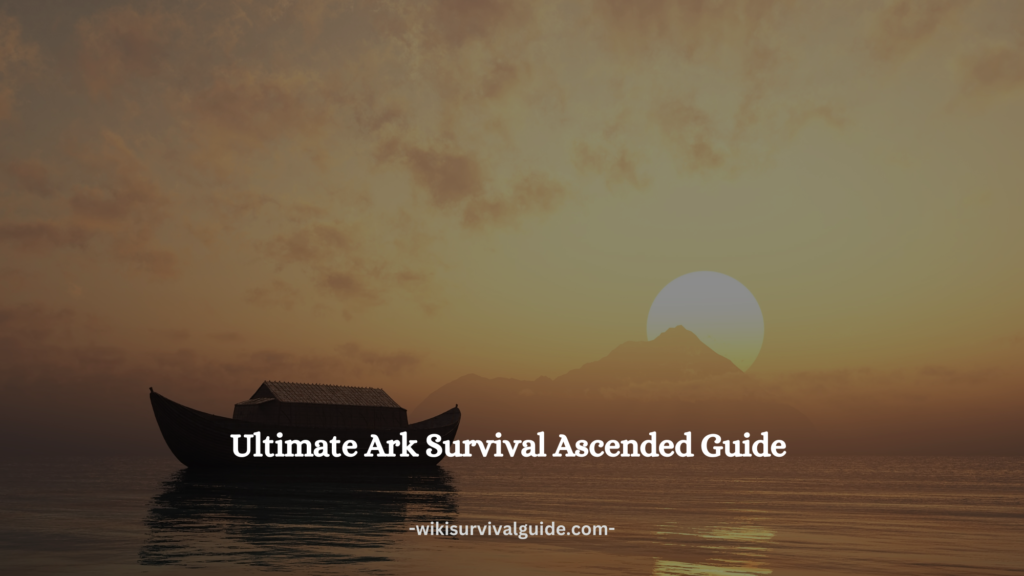Surviving in Ark Survival Ascended is no easy task. From taming deadly dinosaurs to building fortified bases, every decision impacts your survival. Whether you’re new to the game or a seasoned survivor, mastering the mechanics is key to thriving in this prehistoric world. This Ark Survival Ascended Guide will walk you through everything—from choosing the right base location to unlocking Tek gear and conquering boss fights.

Survival Basics for New Players
Surviving in a hostile environment as a new player requires quick adaptation, resource management, and strategic decision-making. The first step is understanding the basics: food, water, shelter, and defense. Prioritize gathering essential resources like wood, stone, fiber, and berries. These materials are crucial for crafting early tools and weapons, such as stone hatchets and spears, which help in defense and resource collection.
Crafting a basic shelter is critical to protect yourself from environmental hazards and aggressive creatures. Start with a simple thatch hut before upgrading to wood or stone structures for better durability. Keep an eye on your stamina, health, hunger, and hydration bars—neglecting them can lead to an early demise.
Exploration is important, but reckless wandering can be dangerous. Always carry basic supplies, including food, water, and extra tools. Keeping a campfire lit at night provides warmth and a way to cook food, preventing starvation.
Avoid engaging large predators early on—running is often the best strategy. Instead, focus on taming small, useful creatures like Dodos and Dilophosaurs for early benefits. Building near water sources ensures easy hydration and fishing opportunities.
Finally, learn the engram system efficiently by unlocking only the most necessary items first. Tools, weapons, storage boxes, and simple clothing should be prioritized. Mastering these survival basics will ensure a strong start and a solid foundation for long-term success.
Best Starting Locations and Base Building Tips
Choosing the right starting location can mean the difference between thriving and struggling. Safe zones near water sources with abundant trees, rocks, and wildlife make ideal beginner spots. Avoid spawning in areas dominated by aggressive predators such as Raptors and Spinosaurus.
Coastal regions are recommended for beginners due to their accessibility to resources and relatively fewer threats. However, inland bases offer more protection from other players in PVP settings. Before building a base, scout the surroundings to ensure it’s not near a high-traffic predator zone.
Start with a simple thatch structure but upgrade to wood and eventually stone to withstand enemy raids and dinosaur attacks. A good base should have storage boxes for supplies, a crafting area, a bed for respawning, and a secure perimeter. Walls and spike barricades can deter both wild creatures and hostile players.
Elevation plays a significant role in base defense. Building on cliffs or high terrain makes it harder for predators and players to attack. If you’re in a PVP server, avoid making your base too obvious—hidden locations reduce the risk of raids.
Expansion is necessary as you progress. Construct a secondary base or safe house in another region to have backup resources and an escape option. Utilizing natural barriers such as rivers, cliffs, and caves can make base defense easier.
Lastly, prioritize storage and organization. A well-structured base should separate crafting stations, storage areas, and taming pens. This ensures efficiency and prevents clutter, allowing for quicker access to essential supplies.
Essential Resources and How to Gather Them Fast
Resources are the foundation of survival, and knowing how to gather them efficiently saves time and effort. Early-game resources include wood, stone, thatch, fiber, and berries. Tools such as pickaxes and hatchets greatly improve collection speed.
Wood and thatch come from trees, but using different tools yields different results. A hatchet collects more wood, while a pickaxe gathers more thatch. Fiber, essential for crafting early structures and gear, is harvested from bushes without tools.
Stone can be picked up from the ground or mined from boulders. Using a pickaxe yields more flint, while a hatchet provides more stone. Flint is needed for making arrows and torches, making it a crucial resource for long-term survival.
Hunting small creatures like Dodos and Lystrosaurus provides raw meat and hide, both necessary for crafting and cooking food. As you progress, larger animals like Triceratops offer greater resource yields. Killing fish grants meat and oil, which are valuable for crafting later in the game.
Metal is a mid-game resource commonly found on mountains and riverbeds. Using a metal pickaxe increases the yield significantly. Once obtained, refining metal into ingots unlocks advanced weapons, tools, and structures.
A key tip for gathering quickly is taming dinosaurs. Dinosaurs like Doedicurus harvest stone efficiently, while Ankylosaurus is best for metal farming. Therizinosaurus is a versatile harvester, collecting fiber, berries, and wood with ease.
Efficient gathering means planning routes. Identify high-yield areas and create storage boxes along your path to minimize trips back to your base. Proper resource management ensures steady progress without unnecessary setbacks.
Top Dinosaurs to Tame for Early, Mid, and Late Game
Taming dinosaurs is a crucial step in progression, providing advantages in combat, resource gathering, and transportation. Choosing the right dinosaurs at each stage ensures survival and efficiency.
Early Game:
- Parasaur: Fast, easy to tame, and has an alarm ability to detect enemies.
- Dilophosaurus: A simple yet effective combat pet that spits venom to slow enemies.
- Triceratops: Great for berry gathering and provides decent early-game defense.
- Iguanodon: Doesn’t consume stamina while running, making it a great travel companion.
Mid-Game:
- Argentavis: A flying mount that can carry large resources and creatures.
- Ankylosaurus: Best for farming metal, flint, and obsidian.
- Doedicurus: The best dinosaur for gathering stone quickly.
- Beelzebufo: Excellent for harvesting cementing paste and traversing swamps.
Late Game:
- T-Rex: A dominant force in combat, essential for boss fights and PVP encounters.
- Quetzalcoatlus: A massive flying mount capable of carrying structures and supplies.
- Therizinosaurus: One of the best all-around gatherers for fiber, wood, and berries.
- Giganotosaurus: The most powerful land predator, capable of destroying almost anything.
Taming strategies vary, but most involve tranquilizing with darts or arrows before feeding the dinosaur its preferred food. Building taming pens can prevent wild creatures from interfering, increasing success rates.
Each dinosaur serves a specific purpose, and prioritizing the right ones ensures faster progression and resource collection.
How to Farm XP and Level Up Quickly
Leveling up efficiently allows faster access to advanced weapons, tools, and skills. The best way to gain XP is through a combination of hunting, crafting, exploring, and taming.
Hunting creatures grants high XP, with larger dinosaurs providing better rewards. Killing Alpha creatures offers an even greater XP boost. Utilizing high-damage weapons or tamed creatures speeds up the process.
Crafting is another effective method. Repeatedly crafting high-value items, such as narcotics, storage boxes, and stone structures, provides consistent XP. Bulk crafting before logging off maximizes passive XP gains.
Exploration also yields experience. Discovering new areas, unlocking Explorer Notes, and traveling across biomes reward XP boosts. Utilizing an XP multiplier before exploring significantly accelerates level progression.
Taming dinosaurs grants XP not only for the tamed creature but also for the player. The larger and rarer the dinosaur, the more XP earned.
Tribe XP sharing allows players to gain experience from teammates’ actions, making teamwork highly beneficial.
For fast early-game leveling, focus on crafting, killing small creatures, and exploring safe zones. Mid-game XP farming should emphasize taming and hunting Alpha creatures. In the late game, boss fights and advanced crafting provide the highest XP rewards.
Combining multiple XP-earning methods ensures rapid progression, unlocking powerful tools and skills essential for long-term survival.
Best Weapons and Armor for Survival and Combat
In a hostile environment, having the best weapons and armor ensures survival against wild creatures, enemy players, and powerful bosses. Your choice of gear depends on whether you’re playing PvE or PvP, as each requires different strategies.
Best Weapons:
- Early Game: Stone spears and slingshots work well for basic defense. Bows with tranquilizer arrows are crucial for taming dinosaurs.
- Mid-Game: Crossbows provide better range and damage, while shotguns are excellent for close combat. The longneck rifle with tranquilizer darts makes taming easier.
- Late Game: Assault rifles, rocket launchers, and tek-tier weapons dominate high-level combat. Pump-action shotguns and fabricated sniper rifles offer precision and power.
Best Armor:
- Cloth Armor: Useful for hot environments but offers little protection.
- Hide Armor: A solid early-game choice, providing moderate defense.
- Chitin Armor: Good against smaller enemies but weak against powerful attacks.
- Flak Armor: Offers high protection, essential for combat.
- Ghillie Suit: Useful for stealth missions and reducing heat exposure.
- Riot Gear: Best for PvP scenarios, reducing damage from bullets and melee attacks.
- Tek Armor: The ultimate defense, offering flight, enhanced vision, and resistance to environmental hazards.
Having backup weapons and armor is crucial, especially in PvP. Regularly repairing gear prevents unexpected breakdowns during fights. Pairing weapons with the right armor ensures the best possible defense and attack capabilities.
PvE vs. PvP Strategies for Long-Term Survival
Surviving in PvE and PvP requires different approaches. While PvE focuses on taming, resource management, and boss fights, PvP emphasizes base defense, combat tactics, and strategic alliances.
PvE Strategies:
- Base Location: Build in safe zones near resources and away from high-level predators.
- Dinosaur Taming: Prioritize utility dinosaurs for farming resources and strong mounts for exploration.
- Boss Battles: Work towards defeating bosses to unlock Tek gear and rare blueprints.
- Resource Protection: Keep extra storage hidden to avoid losing everything to theft or accidental destruction.
PvP Strategies:
- Base Defense: Build hidden or heavily fortified bases with turrets, spike walls, and multiple layers of security.
- Raiding Strategy: Attack enemy bases at night or during offline hours for minimal resistance.
- Tribe Alliances: Forming alliances increases protection and provides better access to shared resources.
- Combat Preparation: Always carry backup weapons, medical brews, and escape plans for unexpected fights.
Choosing the right strategy depends on your playstyle. In PvE, patience and planning lead to long-term survival, while in PvP, aggression and adaptability determine success.
Breeding Guide for Stronger and More Powerful Creatures
Breeding dinosaurs enhances their stats, creating stronger creatures for combat, resource gathering, and boss fights. The process requires careful selection of high-level parents, incubation management, and imprinting bonuses.
Breeding Basics:
- Select the highest-level parents with desirable traits such as high health, stamina, and melee damage.
- Enable mating in an enclosed space to prevent interruptions from wild creatures.
- Eggs from certain species require specific temperature conditions; use air conditioners or campfires to regulate heat.
Hatching and Raising:
- Once an egg hatches or a live birth occurs, feed the baby consistently to prevent starvation.
- Imprinting by interacting with the baby at set intervals boosts stats significantly.
- Use cryopods for easier management and to reduce food consumption while raising multiple creatures.
Stat Stacking:
- Breeding multiple generations improves key stats.
- Avoid mutations that lower important attributes.
- Focus on breeding for specific needs, such as weight for farming dinos or damage for combat mounts.
By following a structured breeding program, players can create creatures capable of handling the toughest challenges in both PvE and PvP.
How to Defeat Bosses and Unlock Tek Gear
Boss battles are among the most challenging parts of the game, requiring strong dinosaurs, high-end gear, and a solid strategy. Defeating bosses grants access to Tek gear, unlocking advanced technology for superior survival.
Preparing for Boss Fights:
- Gather high-level dinosaurs like Rexes, Therizinosaurus, and Yutyrannus for support.
- Equip strong armor, medical brews, and stimulant items to counter status effects.
- Bring a group of players or AI-controlled creatures for coordinated attacks.
Boss Battle Strategies:
- Use Yutyrannus to buff allied creatures with courage roar.
- Keep a balance between damage dealers and tanky dinos to absorb boss attacks.
- Target weak points and avoid unnecessary damage to conserve resources.
Unlocking Tek Gear:
- Tek gear requires defeating bosses and obtaining element for crafting.
- Tek armor provides advanced mobility, flight, and increased damage resistance.
- Tek structures offer the best defense against raiders in PvP.
Mastering boss fights is essential for reaching the highest levels of gameplay, giving players access to the most powerful equipment and structures.
Achievements and Trophy Guide for 100% Completion
For completionists, unlocking all achievements and trophies in the game is a rewarding challenge. Some require exploration, while others involve defeating bosses, taming rare creatures, or crafting specific items.
Exploration Achievements:
- Discovering all Explorer Notes grants a massive XP boost.
- Visiting every biome and landmark unlocks map-related achievements.
Taming Achievements:
- Taming apex predators like the Giganotosaurus earns rare trophies.
- Breeding and imprinting a perfect dinosaur unlocks high-tier achievements.
Combat Achievements:
- Defeating all major bosses, including the Overseer, grants special Tek rewards.
- Winning a PvP battle with specific weapons unlocks skill-based trophies.
Crafting Achievements:
- Creating a full Tek set marks progression into the endgame.
- Crafting every type of weapon and structure completes the builder-related achievements.
Completing all achievements requires dedication and mastery of multiple game mechanics. Players who reach 100% completion earn the title of ultimate survivor.
Cave Exploration and Loot Guide
Caves offer some of the best loot in the game but come with significant dangers, including environmental hazards, aggressive creatures, and narrow passageways. Proper preparation is key to successfully navigating caves and securing valuable artifacts.
Preparation Tips:
- Gear Up: Bring high-quality armor (Flak or Riot) for protection, medical brews for healing, and a torch for visibility.
- Weapons: Shotguns and assault rifles work best against cave creatures, while grappling hooks and climbing picks help with vertical mobility.
- Dinos: Small creatures like Direwolves and Sabertooths are useful for combat in tight spaces.
Types of Caves:
- Artifact Caves: Contain essential artifacts for summoning bosses.
- Resource Caves: Rich in rare materials like crystal, obsidian, and black pearls.
- Underwater Caves: Hold valuable loot but require scuba gear and powerful water dinos for protection.
Loot and Rewards:
- Caves often contain high-tier blueprints for weapons, saddles, and armor.
- Boss artifacts found in caves are required to unlock endgame Tek gear.
- Explorer Notes scattered in caves provide XP boosts for faster leveling.
Approaching caves with a well-planned strategy ensures survival and maximizes the rewards obtained from these dangerous but lucrative locations.
How to Survive Against Hostile Creatures and Players
Survival in the game means dealing with both AI-controlled creatures and unpredictable human players. Understanding their behavior and preparing accordingly is crucial for staying alive.
Against Creatures:
- Know Your Environment: Some biomes have more aggressive creatures. Swamps have Titanoboas, while mountains contain powerful carnivores.
- Use Terrain to Your Advantage: Climbing high ground or using structures can prevent creatures from reaching you.
- Dino Taming Strategy: Having a strong dinosaur companion like a Rex or Spino can help counter aggressive wildlife.
Against Players (PvP Survival):
- Stay Hidden: Building bases in less obvious locations prevents easy detection by raiders.
- Defensive Tactics: Use metal structures, turret defenses, and spike walls to deter attacks.
- Combat Readiness: Always carry backup weapons, healing brews, and escape plans.
Whether in PvE or PvP, survival depends on situational awareness, strong defenses, and having the right tools for the job.
Advanced Building Techniques for Maximum Defense
A well-defended base is essential for both PvE and PvP survival. Advanced building techniques ensure security against both AI threats and player raids.
Choosing the Best Location:
- Cliff Bases: Harder to reach, reducing chances of enemy attacks.
- Underwater Bases: Hidden from most threats but require specialized gear.
- Cave Bases: Naturally fortified with limited entry points.
Building Defenses:
- Metal Structures: Stronger than stone and difficult to destroy.
- Turrets and Traps: Auto-turrets, bear traps, and plant species X provide additional security.
- Multiple Layers: Using honeycomb designs and hidden compartments prevents quick break-ins.
Raid Protection Strategies:
- Dummy Bases: Building decoy bases to mislead attackers.
- Resource Storage: Keeping backup supplies in separate locations ensures survival after raids.
- Tribe Coordination: Assigning defensive roles to tribe members strengthens base security.
Using these advanced techniques ensures a stronghold capable of withstanding attacks from both creatures and players.
Water Dinos and Underwater Exploration Tips
Exploring underwater environments unlocks rare resources, hidden caves, and deep-sea creatures, but requires proper preparation.
Best Water Dinos for Exploration:
- Mosasaurus: Powerful and fast, great for combat and travel.
- Basilosaurus: Immune to jellyfish and deep-sea pressure, ideal for long journeys.
- Megalodon: Fast and aggressive, good for PvP and defending underwater bases.
- Tusoteuthis: The giant squid can grab and immobilize enemies, making it a top-tier ocean predator.
Essential Gear for Underwater Exploration:
- Scuba Suit: Prevents drowning and allows extended diving.
- Crossbow with Tranq Arrows: Useful for taming sea creatures.
- Harpoon Gun: Effective against hostile ocean creatures and enemy players.
Underwater Caves and Resources:
- Deep-sea caves contain high-tier loot, rare artifacts, and black pearls.
- Oil and silica pearls are abundant underwater, necessary for crafting advanced equipment.
- Underwater base locations provide security from land-based threats.
Mastering underwater travel allows access to some of the game’s most valuable resources and strongest creatures.
How to Set Up Efficient Farms for Food and Resources
Farming is essential for producing a steady supply of food, crafting materials, and taming supplies. Setting up an efficient farm ensures self-sufficiency and long-term survival.
Basic Farming Requirements:
- Crop Plots: Needed to grow berries and vegetables.
- Irrigation System: Water pipes connected to a nearby source keep crops hydrated.
- Fertilizer: Dung Beetles and compost bins produce high-quality fertilizer for faster crop growth.
Best Crops to Grow:
- Mejoberries: Essential for taming dinosaurs.
- Citronal, Longrass, Rockarrot, and Savoroot: Used in advanced recipes and kibble.
- Narcoberries: Necessary for crafting narcotics to tranquilize creatures.
Livestock and Animal Farming:
- Dodos and Hesperornis: Provide eggs for kibble.
- Ovis (Sheep): Wool and mutton are valuable for crafting and taming.
- Bees: Producing honey is useful for taming and crafting special items.
Automation for Efficiency:
- Feeding Troughs: Keep dinosaurs fed without manual effort.
- Industrial Cooker: Speeds up advanced food crafting.
- Greenhouse Effect: Using greenhouse structures increases crop growth speed.
A well-planned farm ensures a steady supply of food, allowing for more focus on exploration, combat, and base expansion.
Raid and Defense Strategies for PvP Servers
PvP servers are a constant battleground where only the strongest and smartest survive. Whether launching raids or defending your base, strategic planning is key.
Raiding Strategies:
- Scout First: Use a flyer like an Argentavis to survey enemy bases before attacking.
- Offline Raiding: Raiding when enemies are offline reduces resistance but may be considered dishonorable.
- Explosives and Breaching Tools: Bring C4, rockets, and Tek weapons for breaking through metal defenses.
- Divide and Conquer: Attack from multiple angles or use distractions to weaken enemy forces.
- Tame War Dinos: Rexes, Gigas, and Managarmrs can dominate in PvP battles.
Defense Strategies:
- Multiple Base Layers: Honeycomb designs make it harder for raiders to breach your core structures.
- Turrets and Auto-Defenses: Place Plant Species X, Heavy Auto-Turrets, and Tek Turrets strategically.
- Hidden Storage: Keep valuable items in separate, secret locations.
- Spike Walls and Bear Traps: Slow down and damage enemy creatures before they reach your base.
- Tribe Coordination: Assign roles for guarding, scouting, and reinforcing defenses.
A strong defense makes your base nearly impenetrable, while a well-planned raid can bring you massive rewards.
Weather and Environmental Challenges and How to Overcome Them
ARK’s dynamic weather adds an extra survival challenge, from extreme heat to freezing temperatures.
Extreme Heat (Deserts, Volcano Biomes):
- Wear cloth or ghillie armor to stay cool.
- Stay in shaded areas and near water sources.
- Consume Calien Soup to reduce heat effects.
Freezing Temperatures (Snow Biome, Caves):
- Wear Fur Armor or use a torch/fireplace for warmth.
- Consume Fria Curry to resist the cold.
- Use a tamed Otter to boost insulation.
Rain and Fog:
- Limits visibility, so carry a torch or stay inside during foggy conditions.
- Rain refills water containers, reducing dehydration risk.
Sandstorms (Scorched Earth):
- Use goggles or stay indoors to avoid blindness.
- Seek shelter until the storm passes.
Surviving harsh environments requires proper preparation and knowledge of biomes.
How to Tame and Utilize Flyers for Fast Travel
Flying creatures are the best way to navigate ARK’s massive maps quickly. Knowing which ones to tame first can make all the difference.
Best Flyers for Different Roles:
- Pteranodon: Early-game mount, fast but weak in combat.
- Argentavis: Excellent weight capacity and mid-game mobility.
- Griffin: Great speed and dive attack for PvP.
- Wyvern: Powerful attack abilities but cannot carry items.
- Quetzal: Huge weight capacity, ideal for transporting materials and dinos.
Taming Flyers:
- Most require bolas or traps to immobilize.
- Use Tranq Darts or Arrows to knock them out.
- Kibble speeds up taming and provides better stat boosts.
Utilizing Flyers Efficiently:
- Weight Management: Don’t overburden them with heavy items.
- Stamina Conservation: Land frequently to regain stamina during long flights.
- PvP Escapes: Use quick maneuvers and altitude to escape enemy attacks.
Mastering flyer travel allows for better exploration, resource collection, and PvP strategies.
Best Mods and Settings to Enhance Your Gameplay
Mods and server settings can significantly improve your ARK experience, whether in single-player or multiplayer.
Essential Mods:
- Structures Plus (S+): Enhances base building with improved mechanics.
- Ultra Stacks: Increases stack sizes for easier resource management.
- Dino Storage v2: Allows cryo-like storage for dinosaurs.
- Automated Ark: Automates repetitive tasks like feeding and crafting.
- Classic Flyers: Restores old flying mechanics with faster speeds.
Recommended Server Settings:
- Increased Harvesting Rates: Reduces grind time for gathering materials.
- Faster Taming Speeds: Speeds up dinosaur taming without losing balance.
- Lower Food/Water Drain: Makes survival less tedious.
- Custom XP Multipliers: Adjusts leveling speed for a smoother progression.
These mods and settings make gameplay more enjoyable, reducing tedious mechanics while keeping the challenge.
Endgame Content and What to Do After Reaching Max Level
After reaching max level, there are still plenty of challenges and objectives to pursue.
Boss Fights:
- Gather artifacts from caves and fight bosses like the Broodmother, Megapithecus, and Dragon for Tek gear.
- Defeating bosses unlocks high-tech items and engrams for advanced structures.
Tek Tier Progression:
- Craft and use Tek Armor, Tek Saddles, and Tek Weapons to dominate battles.
- Set up Tek Teleporters and Tek Shields for improved base security.
Exploring DLC Content:
- Scorched Earth, Aberration, Extinction, and Genesis each offer new maps, creatures, and challenges.
- Unlock new biomes and endgame creatures like Rock Drakes, Managarmrs, and Titans.
PvP Domination:
- Build alliances or lead massive raids against enemy tribes.
- Create an indestructible base with Tek defenses and turret walls.
Reaching max level is just the beginning—ARK’s endgame provides plenty of high-level challenges for dedicated survivors.
Conclusion
Mastering Ark Survival Ascended takes time, patience, and strategy. Whether you’re taming creatures, exploring caves, or battling in PvP, survival depends on preparation and adaptability. Focus on building a strong base, taming the best dinosaurs, and teaming up with reliable allies. With the right approach, you’ll not only survive but conquer the Ark and thrive in its ever-evolving world.
FAQs
1. What are the best early-game dinosaurs to tame?
The best early-game tames include Parasaur (for scouting), Triceratops (for gathering berries), and Raptor (for speed and combat).
2. How do I farm resources efficiently in Ark Survival Ascended?
Use dinosaurs like Ankylosaurus for metal, Doedicurus for stone, and Therizinosaurus for fiber to speed up resource collection.
3. What’s the best strategy for PvP survival?
Build hidden bases, travel in groups, and set up traps and turrets to defend against raids. Always keep a backup storage of essentials.
4. How do I breed high-level dinosaurs successfully?
Select high-stat parent creatures, use air conditioning units for egg incubation, and imprint on baby dinos to boost their stats.
5. What are the rarest achievements in Ark Survival Ascended?
Some of the hardest achievements include defeating the Alpha bosses, taming a Titanosaur, and mastering all Tek tier technologies.




1 Comment